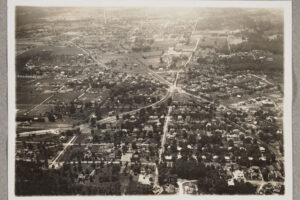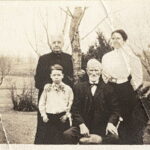A Centennial Storymap
Above: Aerial photo of Clarendon Circle, facing west, soon after 1920. Courtesy Library of Congress.
To commemorate the 2020 centennial of Arlington County, Va.’s renaming, we present a photo “story map” showing images of homes, schools, stores, government buildings, and transportation facilities that existed here in 1920. These are the sights those newly renamed Arlingtonians would see during an early-morning walk or a ride on a horse, car, or trolley.
The name change came after centuries of evolving borders and jurisdictions. Today’s Arlington began in the colonial period as part of Virginia’s Stafford and Fairfax counties under a royal land grant. In 1801, under an act of Congress, our patch became Alexandria County, District of Columbia, part of the new federal capital. In 1846, a much-debated decision was made to retrocede it back to Virginia.
In 1871, a post-Civil War state law allowed residents of the City of Alexandria to separate their policy prerogatives from those of rural Alexandria County. Over the next half-century, our rural ancestors began creating their own schools and businesses, and they welcomed the move of the county courthouse from Old Town Alexandria to the Clarendon area. Life had become increasingly inconvenient for rural Alexandrians, who had to travel to Alexandria City for their legal, commercial, and social affairs.
Perhaps the last straw came after a Sept. 1, 1919, fete honoring recently returned veterans of World War I, held at the Clarendon courthouse. It featured nationally prominent speakers, picnic games, and a military flyover. However, confusion about its location prompted some would-be attendees to attend the courthouse in the City of Alexandria.
A petition for the name change was circulated by the newly consolidated Alexandria Civic Federation. Suggestions for the new name included Pocahontas, Alcova (shorthand for Alexandria County, Va.), George Washington, and Arlington.
The winner, already the name of a county administrative jurisdiction, derived from Arlington House, built from 1802-1818 by George Washington Parke Custis. The home (now on the grounds of Arlington National Cemetery) overlooked the Georgetown-Alexandria Turnpike (at the approximate location of the current Eisenhower Drive in the cemetery), the Potomac River, and the growing City of Washington on the opposite side of the river.
“Arlington” was also the name for the Custis family plantation on the Eastern Shore of Virginia. Confederate hero Robert E. Lee, who married Custis’s daughter and called Arlington home for many years, may have been a factor in the county’s choice of the name.

The bill was introduced in the General Assembly in Richmond by Charles T. Jesse, a Clarendon-based delegate from Alexandria City and Alexandria County. Coverage of Gov. Westmoreland Davis signing it into law appeared as short squibs on the front pages of the Washington Post, the Washington Star, and the Alexandria Gazette on March 12, 1920.
Since 1920, our residents have been able to conduct much of their business and social life within their borders. The link at the top of this page takes you to the photo “story map” of the sights familiar to those newly independent Arlingtonians.
— Charlie Clark, October 2019
Acknowledgments
Local columnist and historian Charlie Clark conceived and coordinated this story project with a grant from the Arlington Historical Society.
Thanks are owed to Rick Millman, director of Arlington County’s Department of Real Estate Assessments, and Jamey Gilliland of Arlington’s GIS Mapping Center for supplying data. Photo-gathering help came from history specialists Tom Dickinson and Eric Dobson, as well as Scott Taylor of the Black Heritage Museum of Arlington. Invaluable help with images came from Judith Knudsen, Arabeth Balasko, and Heather Crocetto of the Arlington Public Library’s Center for Local History. Research help came from Annette Benbow, Cathy Hix, Gerry Laporte of AHS, Cherrydale historian Kathryn Holt Springston, and Beth Trent of Clarendon Presbyterian Church. Also helpful was the 1987 book “Arlington County in Virginia: A Pictorial History” by Nan and Ross Netherton.



